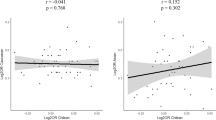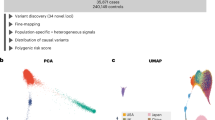Abstract
This study further defines genetic susceptibility to JIA in the region centromeric to HLA-DRB1. DNA from 234 Finnish JIA nuclear families and 639 elderly Finnish control individuals was genotyped for five functional SNPs within the TAP2 and TAP1 loci (∼200 kb centromeric of HLA-DRB1). Subsets of the controls (186) and patients (145) that had been previously typed for HLA-DRB1 were also genotyped by sequence for the HLA-DPB1 locus. Case/control and transmission disequilibrium test (TDT) methods revealed an association with the DPB1*030101 allele for JIA (OR 2.3, 95% CI 1.5–3.5). Notably, a detailed haplotypic analysis of the TAP2/TAP1 loci and their interaction with the HLA-DPB1*030101 and DRB1*08 and *11 alleles showed a variety of over-represented and under-represented TAP2/TAP1 haplotypes not evident in the single marker analysis. The strongest effect was observed in the polyarticular RF negative JIA subgroup for the 2-2-1-2-1 TAP2/TAP1 haplotype (TAP2B and TAP1A alleles) which showed an independent effect from both DRB1*08 and *11 (P<0.000003) and DPB1*030101 (P=0.02). We have provided evidence that the extended haplotypes (including HLA-DRB1, TAP2/TAP1, and HLA-DPB1) of pauciarticular and polyarticular RF negative disease are distinct. This observation may have implications for functional etiological differences between the pauciarticular and polyarticular JIA patients.
This is a preview of subscription content, access via your institution
Access options
Subscribe to this journal
Receive 6 digital issues and online access to articles
$119.00 per year
only $19.83 per issue
Buy this article
- Purchase on Springer Link
- Instant access to full article PDF
Prices may be subject to local taxes which are calculated during checkout
Similar content being viewed by others
References
Glass DN, Giannini EH . Juvenile rheumatoid arthritis as a complex genetic trait. Arthritis Rheum 1999; 42: 2261–2268.
Førre Ø, Smerdel A . Genetic epidemiology of juvenile idiopathic arthritis. Scand J Rheumatol 2002; 31: 123–128.
Albert ED, Scholz S . Juvenile arthritis: genetic update. Baillieres Clin Rheumatol 1998; 12: 209–218.
Petty RE, Southwood TR, Baum J et al. Revision of the proposed classification criteria for juvenile idiopathic arthritis: Durban, 1997. J Rheumatol 1998; 25: 1991–1994.
Barron KS, Silverman ED, Gonzales JC, Owerbach D, Reveille JD . DNA analysis of HLA-DR, DQ, and DP alleles in children with polyarticular juvenile rheumatoid arthritis. J Rheumatol 1992; 19: 1611–1616.
Barron KS, Joseph AK, Macleod M, Gonzales JC, Owerbach D, Reveille JD . DNA analysis of HLA-DR, DQ and DP genes in pauciarticular juvenile rheumatoid arthritis. J Rheumatol 1991; 18: 1723–1729.
Paul C, Schoenwald U, Truckenbrodt H et al. HLA-DP/DR interaction in early onset pauciarticular juvenile chronic arthritis. Immunogenetics 1993; 37: 442–448.
Paul C, Haas JP, Schoenwald U et al. HLA class I/class II interaction in early onset pauciarticular juvenile chronic arthritis. Immunogenetics 1994; 39: 61–64.
Paul C, Yao Z, Nevinny-Stickel C et al. Immunogenetics of juvenile chronic arthritis. I. HLA interaction between A2, DR5/8-DR/DQ, and DPB1*0201 is a general feature of all subsets of early onset pauciarticular juvenile chronic arthritis II. DPB1 polymorphism plays a role in systemic juvenile chronic arthritis. Tissue Antigens 1995; 45: 280–283.
Ploski R, McDowell TL, Symons JA et al. Interaction between HLA-DR and HLA-DP, and between HLA and interleukin 1 alpha in juvenile rheumatoid arthritis indicates heterogeneity of pathogenic mechanisms of the disease. Hum Immunol 1995; 42: 343–347.
Ploski R, Flato B, Vinje O, Maksymowych W, Førre Ø, Thorsby E . Association to HLA-DRB1*08, HLA-DPB1*0301 and homozygosity for an HLA-linked proteasome gene in juvenile ankylosing spondylitis. Hum Immunol 1995; 44: 88–96.
Fernandez-Viña MA, Fink CW, Stastny P . HLA antigens in juvenile arthritis. Pauciarticular and polyarticular juvenile arthritis are immunogenetically distinct. Arthritis Rheum 1990; 33: 1787–1794.
Begovich AB, Bugawan TL, Nepom BS, Klitz W, Nepom GT, Erlich HA . A specific HLA-DP beta allele is associated with pauciarticular juvenile rheumatoid arthritis but not adult rheumatoid arthritis. Proc Natl Acad Sci USA 1989; 86: 9489–9493.
Cerna M, Vavrincova P, Havelka S, Ivaskova E, Stastny P . Class II alleles in juvenile arthritis in Czech children. J Rheumatol 1994; 21: 159–164.
Ploski R, Vinje O, Rønningen KS et al. HLA class II alleles and heterogeneity of juvenile rheumatoid arthritis. DRB1*0101 may define a novel subset of the disease. Arthritis Rheum 1993; 36: 465–472.
Prahalad S, Kingsbury DJ, Griffin TA et al. Polymorphism in the MHC-encoded LMP7 gene: association with JRA without functional significance for immunoproteasome assembly. J Rheumatol 2001; 28: 2320–2325.
Pryhuber KG, Murray KJ, Donnelly P et al. Polymorphism in the LMP2 gene influences disease susceptibility and severity in HLA-B27 associated juvenile rheumatoid arthritis. J Rheumatol 1996; 23: 747–752.
Donn RP, Davies EJ, Holt PL, Thomson W, Ollier W . Increased frequency of TAP2B in early onset pauciarticular juvenile chronic arthritis. Ann Rheum Dis 1994; 53: 261–264.
Ploski R, Undlien DE, Vinje O, Førre Ø, Thorsby E, Ronningen KS . Polymorphism of human major histocompatibility complex-encoded transporter associated with antigen processing (TAP) genes and susceptibility to juvenile rheumatoid arthritis. Hum Immunol 1994; 39: 54–60.
Fernandez-Viña MA, Fink C, Sang S, Stastny P . Peptide transporter genes in susceptibility to juvenile arthritis. Hum Immunol 1993; 37 (Suppl 1): 58.
Runstadler JA, Säilä H, Savolainen A et al. Analysis of MHC region genetics in Finnish patients with juvenile idiopathic arthritis: evidence for different locus-specific effects in polyarticular vs pauciarticular subsets and a shared DRB1 epitope. Genes Immun 2003; 4: 326–335.
Gao X, Fernandez-Viña M, Olsen NJ, Pincus T, Stastny P . Hla-Dpb1 0301 is a major risk factor for rheumatoid factor-negative adult rheumatoid arthritis. Arthritis Rheum 1991; 34: 1310–1312.
Donn RP, Thomson W, Pepper L et al. Antinuclear antibodies in early onset pauciarticular juvenile chronic arthritis (JCA) are associated with HLA-DQB1*0603: a possible JCA-associated human leucocyte antigen haplotype. Br J Rheum 1995; 34: 461–465.
Morling N, Friis J, Fugger L et al. DNA polymorphism of HLA class II genes in pauciarticular juvenile rheumatoid arthritis. Tissue Antigens 1991; 38: 16–23.
Murray K, Thompson SD, Glass DN . Pathogenesis of juvenile chronic arthritis: genetic and environmental factors. Arch Dis Childhood 1997; 77: 530–534.
Van Kerckhove C, Luyrink L, Elma MS et al. HLA-DP/DR interaction in children with juvenile rheumatoid arthritis. Immunogenetics 1990; 32: 364–368.
Carrington M, Colonna M, Spies T, Stephens JC, Mann DL . Haplotypic variation of the transporter associated with antigen processing (TAP) genes and their extension of HLA class II region haplotypes. Immunogenetics 1993; 37: 266–273.
Colonna M, Bresnahan M, Bahram S, Strominger JL, Spies T . Allelic variants of the human putative peptide transporter involved in antigen processing. Proc Natl Acad Sci USA 1992; 89: 3932–3936.
Powis SH, Tonks S, Mockridge I, Kelly AP, Bodmer JG, Trowsdale J . Alleles and haplotypes of the MHC-encoded ABC transporters TAP1 and TAP2. Immunogenetics 1993; 37: 373–380.
Smerdel A, Lie BA, Ploski R et al. A gene in the telomeric HLA complex distinct from HLA-A is involved in predisposition to juvenile idiopathic arthritis. Arthritis Rheum 2002; 46: 1614–1619.
Klitz W, Stephens JC, Grote M, Carrington M . Discordant patterns of linkage disequilibrium of the peptide-transporter loci within the HLA class II region. Am J Hum Genet 1995; 57: 1436–1444.
Jeffreys AJ, Ritchie A, Neumann R . High resolution analysis of haplotype diversity and meiotic crossover in the human TAP2 recombination hotspot. Hum Mol Genet 2000; 9: 725–733.
Cullen M, Erlich H, Klitz W, Carrington M . Molecular mapping of a recombination hotspot located in the second intron of the human TAP2 locus. Am J Hum Genet 1995; 56: 1350–1358.
Bali D, Gourley S, Kostyu DD et al. Genetic analysis of multiplex rheumatoid arthritis families. Genes Immun 1999; 1: 28–36.
Brewer Jr EJ, Bass J, Baum J et al. Current proposed revision of JRA Criteria. JRA Criteria Subcommittee of the Diagnostic and Therapeutic Criteria Committee of the American Rheumatism Section of The Arthritis Foundation. Arthritis Rheum 1977; 20 (Suppl 2): 195–199.
Sham PC, Curtis D . Monte Carlo tests for associations between disease and alleles at highly polymorphic loci. Ann Hum Genet 1995; 59 (Part 1): 97–105.
Laird NM, Horvath S, Xu X . Implementing a unified approach to family-based tests of association. Genet Epidemiol 2000; 19 (Suppl 1): S36–S42.
Horvath S, Xu X, Laird NM . The family based association test method: strategies for studying general genotype–phenotype associations. Eur J Hum Genet 2001; 9: 301–306.
Stephens M, Smith NJ, Donnelly P . A new statistical method for haplotype reconstruction from population data. Am J Hum Genet 2001; 68: 978–989.
Svejgaard A, Ryder LP . HLA and disease associations: detecting the strongest association. Tissue Antigens 1994; 43: 18–27.
Acknowledgements
Dr Runstadler was supported by an NRSA postdoctoral fellowship as a part of the training grant in Comparative Medicine at the University of California, Davis. This work was supported in part by NIH Grant #AR44422, the Academy of Finland (Grant 46558), the Päivikki and Sakari Sohlberg Foundation, the EVO funds of the Rheumatism Association Hospital, and the Helsinki University Central Hospital Research Fund.
Author information
Authors and Affiliations
Corresponding author
Rights and permissions
About this article
Cite this article
Runstadler, J., Säilä, H., Savolainen, A. et al. HLA-DRB1, TAP2/TAP1, and HLA-DPB1 haplotypes in Finnish juvenile idiopathic arthritis: more complexity within the MHC. Genes Immun 5, 562–571 (2004). https://doi.org/10.1038/sj.gene.6364129
Received:
Revised:
Accepted:
Published:
Issue Date:
DOI: https://doi.org/10.1038/sj.gene.6364129
Keywords
This article is cited by
-
Classical HLA-DRB1 and DPB1 alleles account for HLA associations with primary biliary cirrhosis
Genes & Immunity (2012)
-
Finnish case–control and family studies support PTPN22 R620W polymorphism as a risk factor in rheumatoid arthritis, but suggest only minimal or no effect in juvenile idiopathic arthritis
Genes & Immunity (2005)



